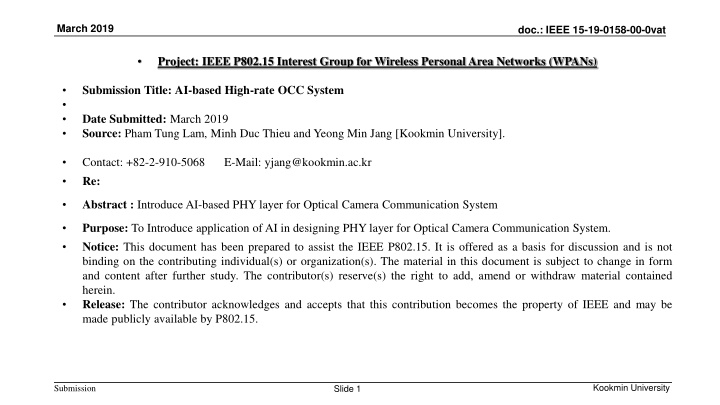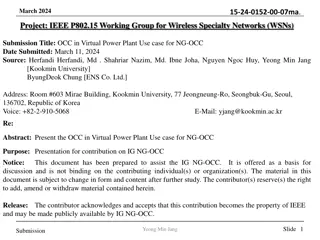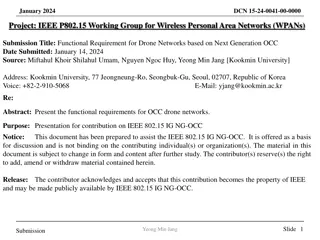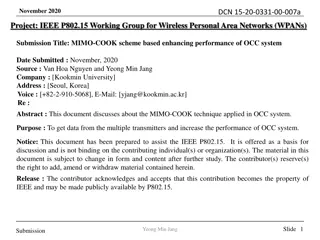
AI-based Optical Camera Communication System Design
Explore the application of artificial intelligence in designing the physical layer for an Optical Camera Communication System. Learn how AI can optimize system performance, reduce complexity, and enhance communication over various channels. Discover potential advancements in signal processing algorithms and channel decoding using AI technologies.
Download Presentation

Please find below an Image/Link to download the presentation.
The content on the website is provided AS IS for your information and personal use only. It may not be sold, licensed, or shared on other websites without obtaining consent from the author. If you encounter any issues during the download, it is possible that the publisher has removed the file from their server.
You are allowed to download the files provided on this website for personal or commercial use, subject to the condition that they are used lawfully. All files are the property of their respective owners.
The content on the website is provided AS IS for your information and personal use only. It may not be sold, licensed, or shared on other websites without obtaining consent from the author.
E N D
Presentation Transcript
March 2019 doc.: IEEE 15-19-0158-00-0vat Project: IEEE P802.15 Interest Group for Wireless Personal Area Networks (WPANs) Submission Title: AI-based High-rate OCC System Date Submitted: March 2019 Source: Pham Tung Lam, Minh Duc Thieu and Yeong Min Jang [Kookmin University]. Contact: +82-2-910-5068 Re: E-Mail: yjang@kookmin.ac.kr Abstract : Introduce AI-based PHY layer for Optical Camera Communication System Purpose: To Introduce application ofAI in designing PHY layer for Optical Camera Communication System. Notice: This document has been prepared to assist the IEEE P802.15. It is offered as a basis for discussion and is not binding on the contributing individual(s) or organization(s). The material in this document is subject to change in form and content after further study. The contributor(s) reserve(s) the right to add, amend or withdraw material contained herein. Release: The contributor acknowledges and accepts that this contribution becomes the property of IEEE and may be made publicly available by P802.15. Kookmin University Submission Slide 1
March 2019 doc.: IEEE 15-18-0501-00-004w AI-based PHY layer for Optical Camera Communication system Submission Slide 2 Kookmin University
doc.: IEEE 15-19-0158-00-0vat March 2019 Potential of AI for PHY layer Most signal processing algorithms in communications have solid foundations in statistics and information theory and are often provably optimal for tractable mathematically models. A practical system, however, has many imperfections and non-linearities. AI-based communication system can be able to approximately describe these type of model and better optimize for such imperfections. Often the communication system design to have a modular structure, each block executes a well defined and isolated function. However, an AI-based communication system don t need to follow such a rigid modular structure as it is optimized for end-to-end performance Reduce the system complexity The execution of AI could be parallelized on concurrent architecture Faster and lower energy cost. Submission Slide 3 Kookmin University
March 2019 doc.: IEEE 15-19-0158-00-0vat Autoencoders A communications system over an AWGN channel represented as an autoencoder. The input s is encoded as a one-hot vector, the output is a probability distribution over all possible messages from which the most likely is picked as output ?. Submission Slide 4 Kookmin University
March 2019 doc.: IEEE 15-19-0158-00-0vat Channel decoding LLR: Log-likelihood ratio BP: Belief Propagation NND: Neural Network Decoder A patitioned NN decoding architecture for polar codes with each Neural Network Decoder decoding a sub-codeword Decoding process is parallel and faster. Submission Slide 5 Kookmin University
March 2019 doc.: IEEE 15-19-0158-00-0vat Neural network architecture for OCC CNN architecture for RoI extracting in OCC system Neural network decoder architecture in OCC system Mostly in OCC system, from RoI extracting to data decoding task can be referred to classification problem, so we can use a convolutional neural network and multilayer fully-connected neural network for OCC system Submission Slide 6 Kookmin University
March 2019 doc.: IEEE 15-19-0158-00-0vat References [1] T. Nguyen, Amirul Islam and Yeong Min Jang, "Region-of-Interest Signaling Vehicular System Using Optical Camera Communications" IEEE Access, 2017. [2] T. Wang, C. Wen, H. Wang, F. Gao, T. Jiang and S. Jin, "Deep learning for wireless physical layer: Opportunities and challenges," in China Communications, vol. 14, no. 11, pp. 92-111, Nov. 2017. [3] T. O Shea and J. Hoydis, "An Introduction to Deep Learning for the Physical Layer," in IEEE Transactions on Cognitive Communications and Networking, vol. 3, no. 4, pp. 563-575, Dec. 2017. Submission Slide 7 Kookmin University






















